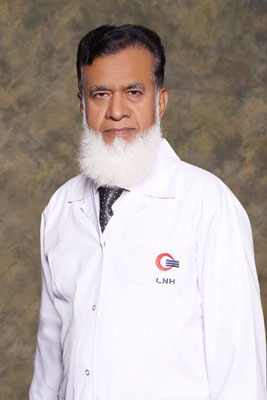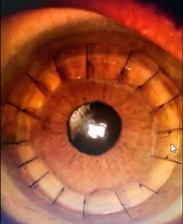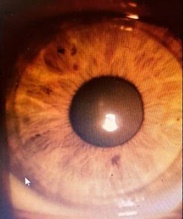Liaquat National Hospital specializes in advanced corneal transplant procedures. Similar to the windscreen of a car, the cornea is the transparent and protective outer layer of the eye. It helps us to see things clearly and lets the light enter the eye. Any disease or infection of the cornea can affect the vision drastically. Corneal infections are very common and difficult to treat. They often leave a scar on the cornea, which causes the vision to get hazy and distorted.
The cornea has three layers (thin outer and inner layers and a thick middle layer). In some diseases, only the inside layer (endothelium) is affected, causing corneal edema (swelling) and clouding. The affected endothelial cells compromise the clarity of the cornea and cause cloudy vision.
A corneal transplant is a surgical ophthalmic procedure in which a healthy cornea is transplanted from a donor's eye to help restore vision. The cornea can be transplanted in full thickness or in layers (more advanced surgery).
Fig: Penetrating Keratoplasty (PK)
Indications of Corneal Transplant
At LNH, the Corneal Transplant is recommended for the following conditions:
- Thinning or tearing of the cornea
- Complications caused by previous eye surgery
- Corneal scarring due to infection or injury
- Keratoconus (cornea that bulges outwards)
- Fuchs' dystrophy (a genetic condition)
- Corneal ulcers
- Corneal degenerations
- Corneal swelling (edema)
Corneal Transplant Techniques at Liaquat National Hospital
DMEK (Descemet's Membrane Endothelial Keratoplasty)
It is a technique where the diseased endothelial cells are removed from your eye and selectively replaced with a new layer of endothelial cells. These new cells are held in place temporarily by a bubble of air inside your eye.
Patients have a very high quality of vision afterwards, many achieving vision of 20/25 or better. DMEK corneal transplant has lowest lifetime risk of graft rejection.
DSEAK (Descemet's Stripping Automated Endothelial Keratoplasty)
DSEAK is a type of Endothelial Keratoplasty where the patient's affected endothelium is removed from the patient’s eye. It is then replaced with a thin layer of donor stroma tissue and Descemet's membrane.
DSEAK is a sutureless cornea transplant technique and has faster recovery than traditional corneal transplants. Patients have a very good quality of vision afterwards, many achieving vision of 20/30 or better. Visual prognosis in 2 years is the same as DMEK, but the recovery takes about 8 weeks compared to 2 weeks.
Recovery and Aftercare of Corneal Transplant Procedures
Complete recovery from a corneal transplant approximately takes 2-3 months. Following post-operative care tips must be followed to ensure successful recovery:
- After surgery, you will be advised to lie flat as much as possible for one to two days and may be required to stay overnight at the hospital.
- A follow-up appointment within one week will be important to assess the graft's position.
- Approximately six follow-up visits are scheduled in the first year.
- Taking about two weeks off work is generally recommended, although you should discuss your work mode and seek advice from your doctor.
Resuming normal activities:
- Work: Plan for at least one week off, potentially longer depending on your job's nature.
- Flying: Air travel restrictions last for one week or, in specific cases, up to 10 days, depending on the remaining gas bubble in the eye.
- Sports activities: Consider waiting for four weeks before resuming activities if the surgery is successful.
- Driving: Wait at least 48 hours before driving, and if you meet legal requirements (such as reading a number plate at 20 meters with your other eye). You can resume driving after 48 hours if you feel comfortable and safe to do so. It's crucial to be cautious to avoid accidental injuries during the adjustment period to your new eyesight.
- Environment: Stay away from dusty and smoky environment to prevent any damage.
Benefits of Corneal Transplant
Improved vision
- The majority of transplant recipients have good enough vision to be able to drive legally, although they usually need glasses.
- It can take up to six months until the full improvement is seen.
- It avoids the need for a full-thickness corneal graft, which means fewer surgical complications and less risk of loss of sight.
Relief from Pain and Discomfort
- For people experiencing pain, discomfort, or irritation due to corneal diseases, a transplant can provide relief from these symptoms.
Prevention of Further Damage
- By addressing underlying corneal conditions, a transplant can prevent further damage to the eye and stop the progression of diseases that may compromise vision.
Customized Surgical Techniques
- Advances in corneal transplant techniques, such as DMEK and DSEAK, allow for more targeted and customized approaches.
Risks and Side Effects of Corneal Transplant
Corneal transplants, while generally safe, carry potential risks and side effects. Some of the complications include:
Graft Failure
Gradual graft failure can occur, usually after five or more years, due to the natural loss of transplanted endothelial cells or rejection by the body. Failed graft tissue may require replacement through another operation in the future.
Graft Dislocation/Detachment
Approximately 20% of Descemet Membrane Endothelial Keratoplasty (DMEK) grafts may dislocate. This can be treated by repositioning through air or gas injection in the eye.
Temporary Increased Eye Pressure (Glaucoma)
Around 5% of patients may experience a temporary increase in eye pressure following the procedure.
Graft Rejection
Graft rejection is a potential complication, manifesting with symptoms such as a red eye, sensitivity to light, visual loss, pain, and blurred vision. If rejection occurs, prompt medical attention is crucial.
Blurred Vision due to Macular Edema
Less than 5% of patients may experience blurred vision caused by macular edema. This is typically temporary.
Retinal Detachment
While the risk is low, there is a possibility of retinal detachment after the procedure. In this condition, the back inside surface of your eye (retina) pulls away from its normal position.
Sight-Threatening Infection
In rare cases, a sight-threatening infection may occur, estimated at approximately 1 in 1,000 cases.
Other complications include:
- Cataract
- Swelling of the cornea
Training & Education
Regular teaching in clinics, regarding corneal diseases, and training in corneal surgery, including corneal repair, amniotic membrane graft and corneal transplant is the part of our practice.
Frequently Asked Questions
Corneal transplant is a surgical procedure where diseased or opaque cornea is replaced by a clear cornea. Also, if the eye is perforated and is severely infected that it might perforate.
There are a lot of eye diseases affecting the cornea which can damage it. It can be a trauma, infection, some hereditary dystrophies, keratoconus and damages secondary to previous operations.
Usually, patients who have diseased endothelial cells due to Fuchs' dystrophy or following cataract surgery, with none or minimal scarring of the cornea, are suitable for this procedure.
Donor cornea comes from an eye donor who signs a donor card in his / her life but the cornea is removed immediately after his / her death. At present, most corneas come from eye banks in Sri Lanka and USA.
Mostly the procedure is done under General Anesthesia as a day care procedure but, sometimes the patient is kept in hospital for one day. You need to be off work for at least 3 to 4 weeks and rest a lot. Computer and on line work can be started earlier.
Your vision after corneal transplant will be misty for a few days, but it will improve over the next three to four months as the cornea gradually clears.
You need a complete or partial rest for one to two weeks. Avoid heavy work and bending etc. There will be frequent use of eye drops initially which is reduced gradually in frequency and amount. Avoid prolonged screen work initially and pray without bending. Sleep with a shield on and do not lie down on the operated side.
Corneal transplant is the most successful organ transplant done worldwide. But sometimes we get raised pressure in the eye or infection in the graft. Sometimes, body try to react and reject the graft. Most of the time we can control this with drops and medicines. But, occasionally it does fail and is not successful. In such cases, we can do the transplant again and mostly it works well. Remember, if you need a corneal transplant then that is the only treatment which will cure your condition and there is no alternate to it so consider it after understanding all the pros and cons.
Unlike traditional cornea transplant methods that involve stitching, a suture-less transplant or endothelial keratoplasty procedure uses techniques like DMEK and DSEAK. These advanced techniques does not require any stitches, instead the donor tissues are held in place by an air bubble. It allows for faster recovery and reduced complications.
Screen usage is restricted during the initial phase of recovery which is about 2-3 days. Follow the postoperative care instructions provided by your surgeon and consult with them if you have specific concerns about screen time.
Yes, corneal transplant can be repeated if necessary. The decision to undergo a repeat corneal transplant depends on various factors, such as the reason for the initial transplant's failure, the health of the eye, and the patient's overall condition.
Usually, patients who have diseased endothelial cells due to Fuchs' dystrophy or following cataract surgery, with none or minimal scarring of the cornea, are suitable for this procedure.
While it is possible to perform DSEK on both eyes simultaneously, this decision depends on the surgeon's recommendation and the patient's overall health.
Faculty











